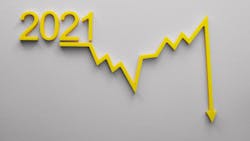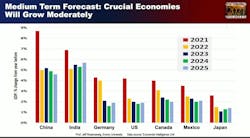The economic portion of the 2021 Heavy Duty Aftermarket Dialogue (HDAD), held on Jan. 25 by the Heavy Duty Manufacturers Association and MacKay & Company, began on a somber note, with Jeff Rosensweig, an Emory University professor with expertise in international business, government and public policy, explaining how bad things were financially for America in 2020— and how the future could be even worse.
He kicked things off by pointing out the national deficit jumped $4.2 trillion to $27.7 trillion as the government attempted to stimulate the economy during the COVID-19-induced recession.
“There's nothing like it in world history,” Rosensweig said, recounting that Congress had to take these measures to keep the country from “a full-scale, long-term depression.”
These actions may have worked, as the initial 22 million jobs eliminated due to the pandemic, subsequent lockdowns, and general state of fear became a net 10 million job loss. Overall, real GDP dropped 3.5%, which is no small miracle as 2020 Q2 GDP dropped 32%.
And Rosensweig is predicting 2021 will be a “bounce back” year: “As demand rises, hopefully the vaccine will get people out shopping again and going to restaurants.”
“We show the U.S. forecast is over 4% growth of the economy in 2021,” he said, noting average GDP has been around 2% for the last decade. That type of modest growth will return to about 2.2% in 2022.
But GDP does not tell the full story. The New York Times, using Centers for Disease Control and Prevention data, found 356,000 more people died from March 2020 to November 2020. The largest portion is believed to be from COVID-19, though inaccessibility to regular healthcare caused spikes in diabetes, Alzheimers, heart disease, and other leading causes of death.
In September 2020, Yelp reported nearly 100,000 small businesses closed down permanently. The initial decline of 22 million was mitigated by a gain of 12 million since the stimulus efforts.
One factor working against a true recovery is that while inflation is expected to be 2% in the next few years, Rosensweig expected that could increase beyond that. President Joe Biden's administration is also expected to increase the national deficit with a $1.9 trillion stimulus bill. Canceling student debt and funding a Green New Deal have also been proposed, leaving Rosensweig to question the timing and long-term impact.
“Our debt will go through the roof, and we're going to bequeath future generations with more debt than anyone could swallow,” Rosensweig said.
"Biden and [Secretary of the Treasury Janet] Yellen wouldn't be calling for all this spending, if we weren't in a situation where we're worried that the economy might be declining again, into a recession, because the rapid increase in COVID cases in the last month have led to kind of some partial lockdowns, which is slowing the economy," Rosenweig said.
Another area of concern is the Federal Reserve propping up the economy.
“The U.S. Federal Reserve, which had been holding about $4 trillion of bonds, now holds almost $7.5 trillion,” Rosenweig stated. “It has increased in holdings of treasury bonds, or mortgage bonds, some of both, by $3.5 trillion, almost doubling their holdings since February, putting a tremendous amount of credit into the banking system printing money.”
China rising
China, America’s largest and most polarizing rival, has strengthened its position globally. “China, as it's often been in the past, is forecast to be the fastest-growing economy,” Rosensweig said. "They're the only major economy that actually grew in 2020."
"Even though the pandemic started there — in some sense, they exported it to the rest of the world — they locked down so severely at the beginning," he explained.
This included China closing down factories and domestic travel in January, but did not include shutting down international travel. In fact, China criticized the Trump administration’s travel ban imposed on Jan. 29, 2020.
“They got a handle on the pandemic and they most aggressively opened their factories and started their business growing again,” Rosensweig said.
China has also increased shipping freight rates from China to the U.S. Freightos reported a 170% year-over-year increase.
“Inflation in freight rates out of China has just been exorbitant in the last month, and I don't think that's going to change anytime soon,” said Al Dragone, CEO of FleetPride in a separate HDAD session. “So, I think it's going to also open up other markets because we're not seeing that same type of tightness coming out of the [Mediterranean] or even coming out of any of the major markets like Mexico.”
For companies wanting to look elsewhere for truck parts and to prevent the growth of China, Rosensweig suggested looking into the Association of Southeast Asian Nations (ASEAN), which includes Indonesia, Vietnam, Thailand, Malaysia, and the Philippines.
“I would like people to learn more about it, because we do need to move our supply chains away from China,” Rosensweig advised. “And ASEAN [members] are big populations with low wages, but hardworking workers. We need to have more resilient supply chains and move away from China.”
There was still one major factor the U.S. has it can leverage as economic times get tougher.
"I think the number one strength of the U.S. is we still have by far the world's best military," Rosensweig said. "And we have the best universities, and we have freedom."
About the Author
John Hitch
Editor
John Hitch is the editor-in-chief of Fleet Maintenance, providing maintenance management and technicians with the the latest information on the tools and strategies to keep their fleets' commercial vehicles moving. He is based out of Cleveland, Ohio, and was previously senior editor for FleetOwner. He previously wrote about manufacturing and advanced technology for IndustryWeek and New Equipment Digest.


